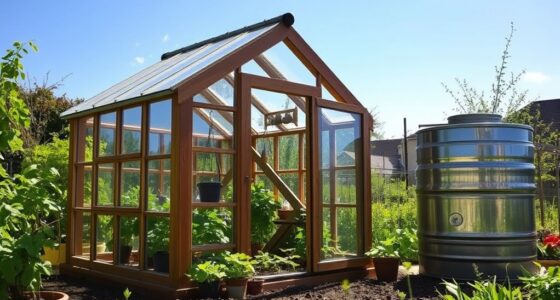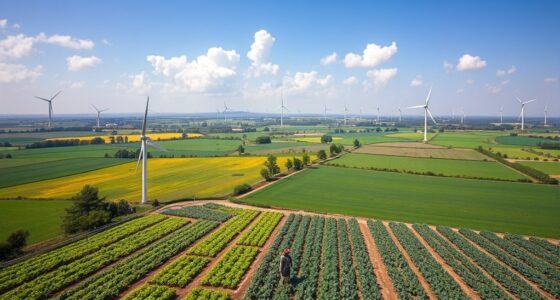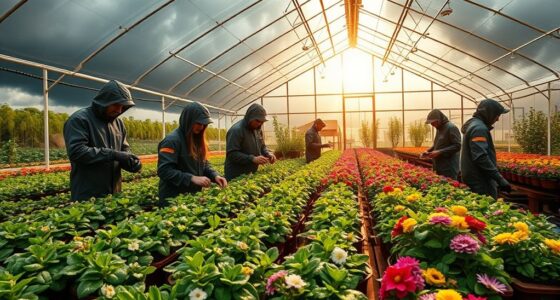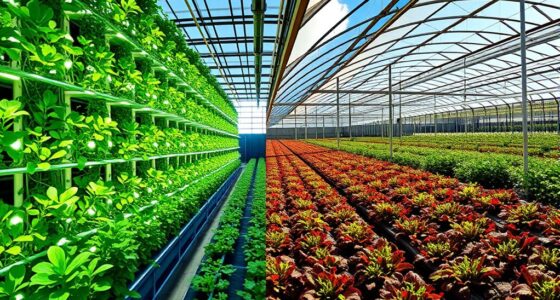Greenhouse farming provides you with economic benefits like year-round production, ensuring market stability and higher yields. With advanced technology, crops thrive in controlled environments, boosting quality and efficiency. Although initial investments can be significant, the long-term returns often surpass traditional farming methods. You’ll also find that sustainable practices reduce operational costs while meeting the growing demand for fresh produce. Keep exploring to uncover more about the opportunities and advantages this innovative farming method offers.
Key Takeaways
- Greenhouse farming provides year-round production, stabilizing income and reducing market fluctuations from seasonal changes and adverse weather conditions.
- Higher yields and superior crop quality achieved through controlled environments lead to increased market prices and profitability.
- Initial investments are offset by long-term ROI, as consistent production allows for premium pricing and long-term contracts with retailers.
- Greenhouses significantly reduce water usage and environmental impact, aligning with sustainable practices that appeal to eco-conscious consumers.
- Technological innovations in greenhouse farming enhance efficiency and productivity, further increasing the economic viability of operations.
Year-Round Production and Market Stability
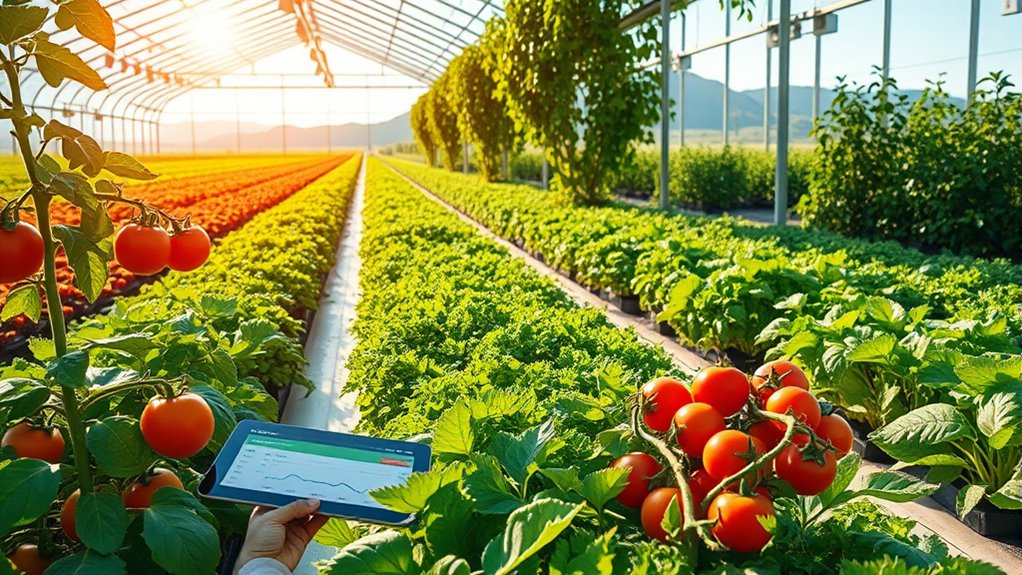
As greenhouse farming thrives, it offers you the ability to produce fresh produce year-round, regardless of seasonal changes. This continuous supply helps you meet market demands, minimizing income fluctuations caused by weather or seasonal limitations. By cultivating a diverse range of crops, including exotic varieties, you gain a competitive edge and tap into niche markets. Consistent production not only stabilizes your income but also allows you to secure long-term contracts with retailers. With reduced seasonal risks, you can create predictable supply chains that benefit both you and your customers. Ultimately, this year-round approach enhances market stability, boosts consumer confidence, and positions you favorably against imported goods, ensuring a more robust economic future. Furthermore, greenhouses provide controlled environments that protect crops from extreme weather, further ensuring consistent yields. Additionally, implementing effective location scouting strategies helps optimize greenhouse placement for maximizing production efficiency. Moreover, using sustainable farming practices can enhance both yield and soil health, resulting in long-term economic benefits. By incorporating greenhouse design principles, you can significantly improve energy efficiency and crop output, contributing to even greater profitability.
Higher Yields and Quality: The Greenhouse Advantage
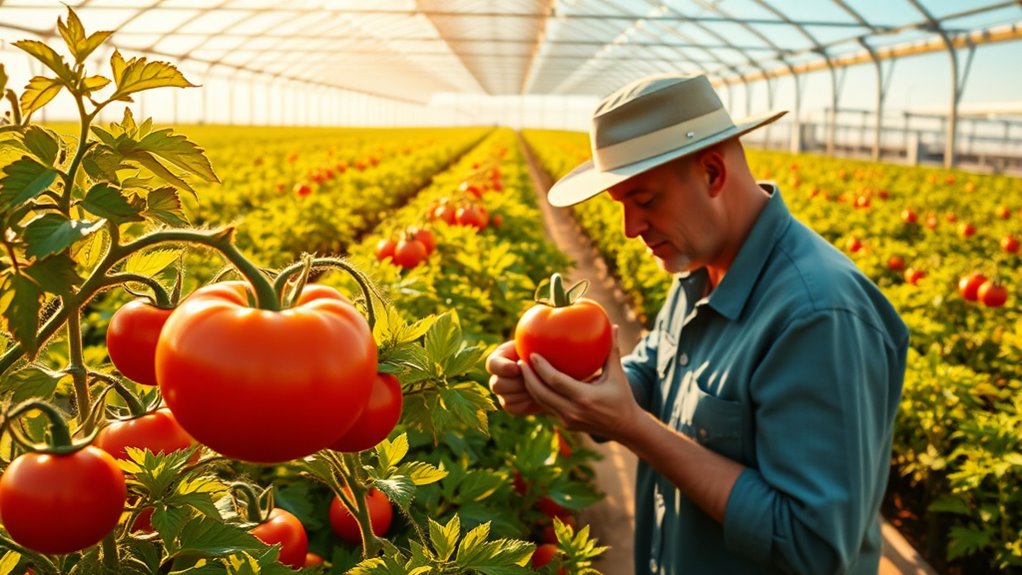
While traditional farming often faces challenges like unpredictable weather and soil degradation, greenhouse farming provides a clear advantage with its ability to deliver higher yields and superior crop quality.
Greenhouses optimize growing conditions, allowing plants to thrive faster and produce more. By controlling the environment, you shield your crops from adverse weather, considerably reducing losses. Additionally, higher yields are achieved through the use of advanced technologies and practices that maximize efficiency. In fact, fresh orange juice retains more nutrients than processed juice, showcasing how controlled environments can enhance the quality of produce. Greenhouses also promote sustainable gardening practices, which further contribute to the health of soil and the surrounding ecosystem. Understanding emotional dysregulation in crops can also lead to better management of their growth conditions.
You can precisely manage water and nutrients, boosting efficiency and enhancing the flavor and nutritional content of your produce.
With the ability to grow diverse crops—even those unsuitable for local climates—you’ll enjoy consistent, premium quality. This reliability not only commands higher market prices but also stabilizes your income, giving you a competitive edge in the agricultural market.
Cost Structure: Initial Investments and Ongoing Expenses

Investing in greenhouse farming requires careful consideration of both initial investments and ongoing expenses, which can quickly add up. You’ll typically spend between $10,000 and $30,000 for basic structures, while advanced models may exceed $50,000. Don’t overlook equipment costs, which can range from $3,000 to $5,000. If you’re leasing land, expect monthly costs between $500 and $2,000. Climate control systems can add another $3,000 to $15,000 to your budget. Ongoing expenses include energy bills from $100 to $600 monthly, along with labor and maintenance costs. Monthly utility costs can vary significantly depending on the greenhouse size and climate, impacting overall profitability. Efficient irrigation systems are vital for reducing water usage, while pest management technologies can help keep your plants healthy. Careful financial planning is essential to maintain profitability in this venture.
Technological Innovations in Greenhouse Farming
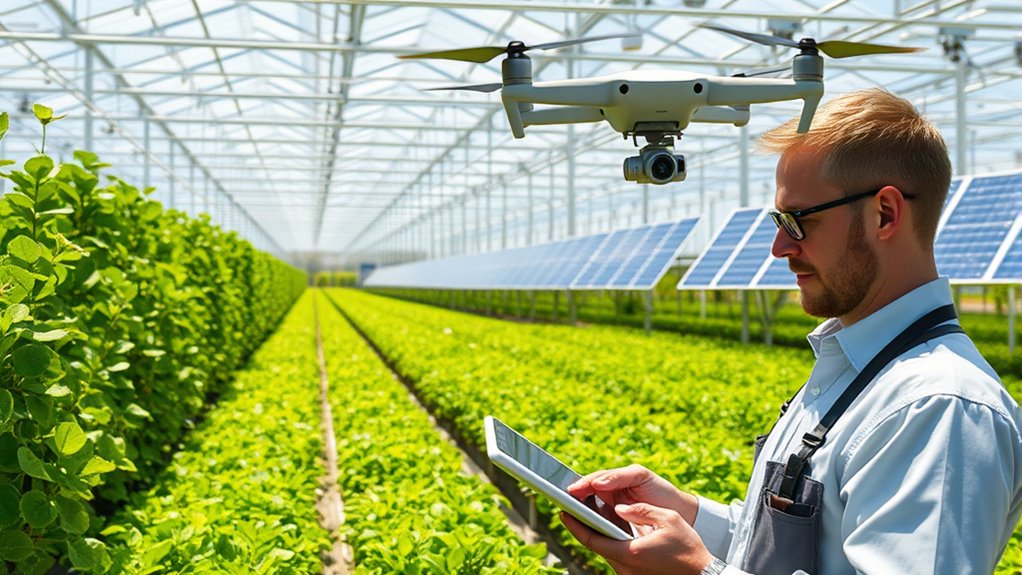
Understanding the cost structure of greenhouse farming sets the stage for recognizing how technological innovations can considerably enhance efficiency and profitability.
Automated systems streamline climate control, optimizing temperature and humidity while slashing labor costs. Precision agriculture leverages sensors and data analytics, allowing you to monitor soil health and make targeted adjustments. Automated systems are also capable of adjusting ventilation, heating, and cooling based on real-time data, further enhancing the growing environment. Additionally, these innovations can lead to substantial energy bill reductions through the use of solar energy solutions. Furthermore, the implementation of strategic planning can ensure that the adoption of these technologies aligns with long-term business goals. Indexed annuities can also provide financial stability, allowing for reinvestment in advanced technologies.
By adopting vertical farming, you can produce crops year-round, even in urban settings. Hydroponics and aeroponics boost yields and conserve water. Robotics take over planting and harvesting, increasing efficiency.
LED grow lights enhance growth in low-light conditions, while real-time monitoring systems help you catch issues early. These advancements not only elevate crop quality but also reduce operational costs, giving you a competitive edge in the market.
Environmental Impact and Sustainability Benefits
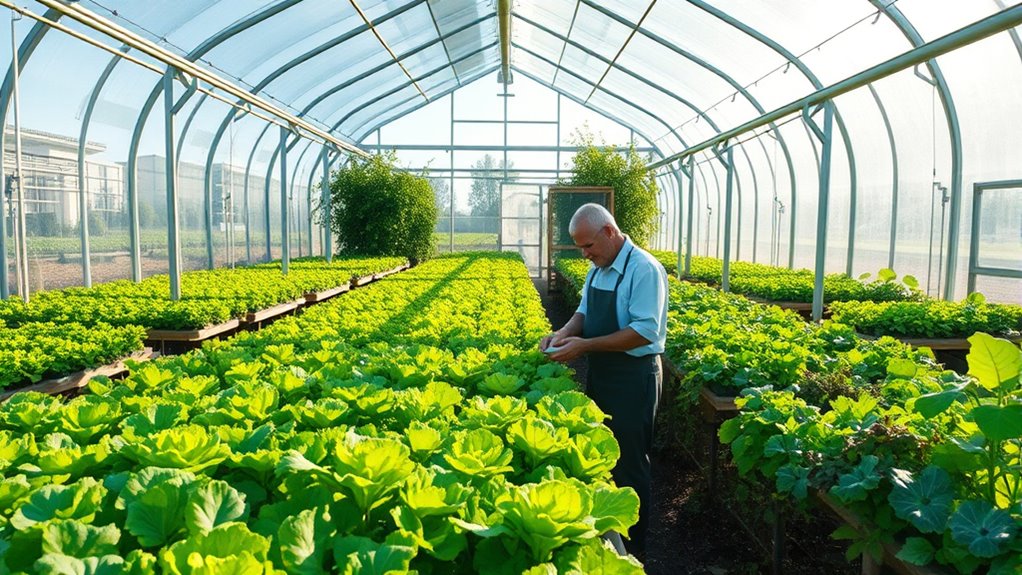
As greenhouse farming gains traction, you’ll find that its environmental impact and sustainability benefits are essential for both producers and consumers.
Greenhouses can reduce water usage by up to 90%, conserving this crucial resource. By growing produce locally, they decrease transportation-related emissions, leading to a smaller carbon footprint. Additionally, growing food in greenhouses can shrink carbon footprints by reducing conventional farming impacts. Moreover, this method aligns with sustainable practices that prioritize responsible resource management and environmental protection. The use of advanced filtration systems in heat pumps can further contribute to enhancing indoor air quality, which complements the clean air benefits of greenhouse farming. Implementing integrated pest management (IPM) also minimizes the use of harmful chemicals, promoting a healthier ecosystem.
Plus, they protect crops from pollutants, ensuring cleaner produce while preserving biodiversity. Year-round production stabilizes supply, and advanced irrigation systems enhance resource efficiency.
Integrating renewable energy sources like solar power minimizes reliance on fossil fuels. Ultimately, greenhouses improve air quality, support local ecosystems, and reduce pollution, making them a sustainable choice for the environment.
Embracing this method means investing in a healthier future for everyone.
Exploring Market Opportunities and Niche Access
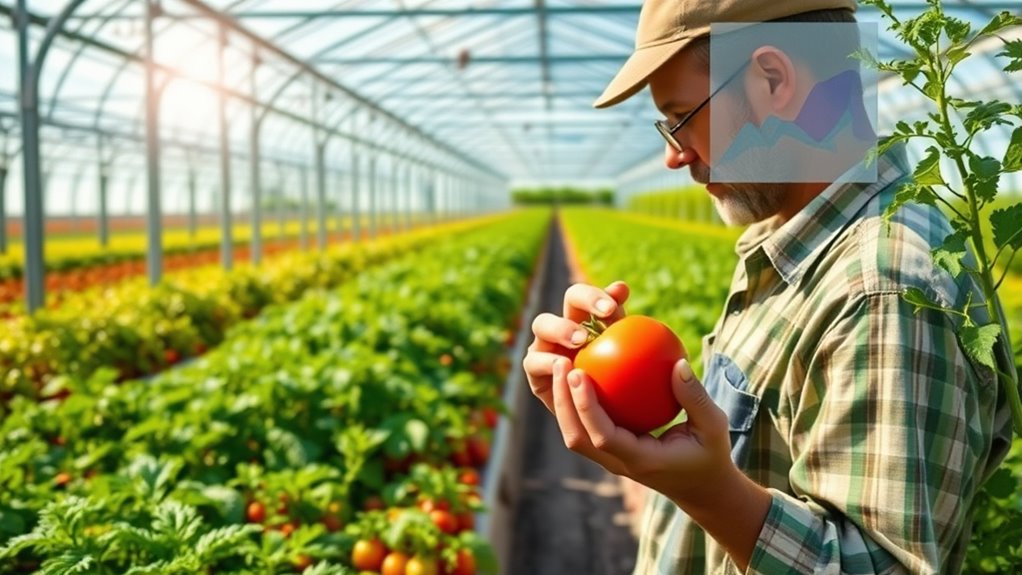
While exploring market opportunities in greenhouse farming, you’ll discover a landscape ripe with potential. The growing demand for local produce means consumers are enthusiastic for fresh, year-round offerings. Greenhouses provide the ideal environment for diversifying crops, minimizing risks from seasonal fluctuations. Technological advancements like automation and data analytics boost efficiency, ensuring robust growth. Moreover, as the global population is expected to reach 9.7 billion by 2050, the need for sustainable food production becomes increasingly critical. Awareness of these pitfalls in traditional farming practices can enhance the effectiveness of greenhouse operations. Additionally, understanding water sources is crucial for optimizing irrigation systems in greenhouse setups. Incorporating nutrient-rich crops into your greenhouse can also improve the health benefits of the produce you offer.
You can tap into niche markets by growing specialty and organic produce, which often commands premium prices. Additionally, consider integrating greenhouse and vertical farming techniques to maximize space in urban settings. Focusing on regions like Europe and Asia-Pacific can also enhance your access to local markets. With these opportunities, you can establish a thriving greenhouse venture that meets modern food demands.
Long-Term Financial Viability and Resource Efficiency
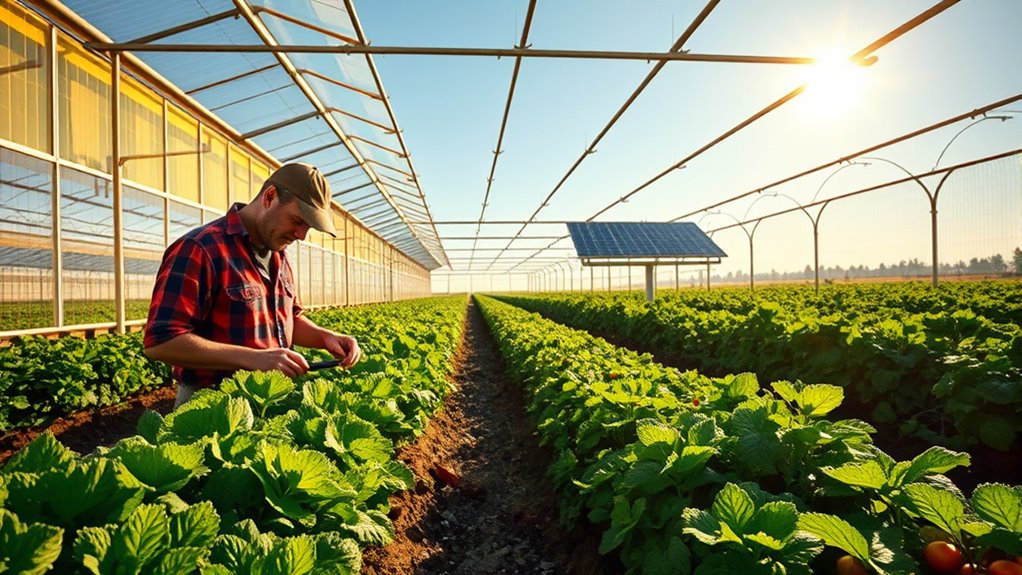
Achieving long-term financial viability in greenhouse farming hinges on strategic planning and resource efficiency. While initial investment costs can be high, your return on investment often surpasses traditional farming, especially with high-value crops. By focusing on consistent yields and premium pricing, you can reach your break-even point efficiently. Government incentives can further alleviate initial costs, enhancing sustainability. Additionally, controlled environments play a crucial role in reducing operational costs over time, making greenhouse farming more economically viable. Understanding state tax implications can also guide your financial planning and investment strategies, optimizing profitability. Proper advance directives can ensure that financial decisions regarding your greenhouse venture are respected in the event of unforeseen circumstances.
Resource efficiency plays a crucial role; utilizing precision irrigation and nutrient management reduces waste and optimizes growth. Integrating renewable energy sources cuts down on operational costs, while techniques like vertical farming maximize space. By managing labor and supply costs effectively, you can lower operational expenses. This holistic approach guarantees financial stability and solidifies your greenhouse farming venture’s long-term success. Furthermore, understanding IRA investment strategies can provide additional funding options that enhance your financial planning for greenhouse operations.
Frequently Asked Questions
What Are the Most Common Crops Grown in Greenhouses?
When you think about common crops grown in greenhouses, tomatoes, cucumbers, and lettuce often come to mind. Their high yields and quick growth cycles make them popular choices.
You might also consider peppers and chilies for their versatility. For fruits, strawberries and blueberries thrive under controlled conditions.
Don’t forget herbs like basil and mint, plus ornamental plants like roses, which can flourish year-round in greenhouses, offering you a diverse range of options.
How Do Weather Conditions Affect Greenhouse Farming?
Think of a greenhouse as a safe haven, shielding your crops from the stormy chaos outside.
Weather conditions like extreme heat, cold, or storms won’t disrupt your plants’ growth. Inside, you can maintain the perfect environment, controlling temperature and humidity.
This stability allows you to produce high-quality crops year-round, regardless of what’s happening outside.
What Are the Best Practices for Greenhouse Maintenance?
To maintain your greenhouse effectively, start with regular cleaning of panels to guarantee peak light transmission.
Check gutters and structural integrity frequently.
Inside, remove plant debris and disinfect tools to prevent disease.
Confirm ventilation systems are operational and consider automating irrigation for efficiency.
Don’t forget to perform seasonal deep cleans and inspect for wear or damage, preparing everything for the next growing season.
Staying organized will also enhance your greenhouse workflow.
Can Greenhouses Be Built in Urban Areas?
Yes, you can build greenhouses in urban areas. They integrate well with existing infrastructure, maximizing space and reducing land costs.
However, you’ll face challenges like high initial expenses and regulatory barriers. Engaging local communities can enhance support and educational benefits.
How Do I Choose the Right Greenhouse Type for My Needs?
Choosing the right greenhouse type is like picking the perfect pair of shoes; it needs to fit your needs just right.
Start by considering what you want to grow—whether it’s vegetables, flowers, or fruit trees. Then, think about your space and climate.
For instance, if you’re in a windy area, a dome greenhouse might be best.
Don’t forget to factor in materials and maintenance.
Make a choice that’ll help your plants thrive!
Conclusion
In summary, greenhouse farming’s economic benefits are clear, offering year-round production, higher yields, and market stability. By embracing cutting-edge technology and sustainable practices, you can tap into niche markets and guarantee long-term financial viability. Think of it as farming with a turbo boost—you’re not just growing crops; you’re cultivating a thriving business that’s both profitable and environmentally friendly. So, gear up and plunge into the world of greenhouse farming; the future’s looking bright!



